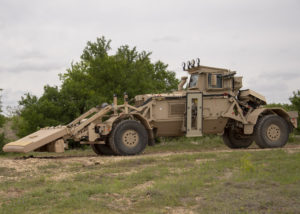By Robert Richardson, Test Officer, Maneuver Support and Sustainment Test Directorate, U.S. Army Operational Test Command
FORT HOOD, Texas – Soldiers from the 937th Engineer Company (Clearance), 20th Engineer Battalion, 36th Engineer Brigade here, trained on their tactical missions while putting some of the Army’s newest route clearance equipment through its paces.
The Husky Mounted Detection System (HMDS) 2 and Explosive Hazard Pre-detonation (EHP) Roller are both designed to improve the ability of route clearance patrols to find and neutralize explosive hazards while decreasing the risk to the Soldiers conducting the route clearance mission.
Both systems have been employed effectively in combat environments under Rapid Fielding Initiatives and are now undergoing the final part of the process to become programs of record within the Army’s acquisition framework.
HMDS 2 and EHP improves on existing platforms and adds some new capabilities to HMDS systems currently in use by Army and Marine Corps route clearance units.
These improvements allow the HMDS operator to more accurately detect and mark potential hazards for the platoon to interrogate.
The EHP Roller is an Army-developed system that attaches to the front of a Medium Mine Protected Vehicle (MMPV) Type II and is designed to pre-detonate mines and pressure plate-initiated improvised explosive devices (IEDs).
Test Officer Edward Jagodzinski, of the U.S. Army Operational Test Command’s (OTC) Maneuver Support and Sustainment Test Directorate (MS2TD) said, “By agreeing to support this combined operational test, the 20th Engineer Battalion received an early fielding of two major vehicle platforms critical to the route clearance mission.
“The Husky Mounted Detection System 2 and the Explosive Hazard Pre-detonation Roller both provide the route clearance unit with Counter Explosive Hazard capabilities.”
Soldiers from the 937th received a week of new equipment training (NET) from the Product Manager (PM) and a week of doctrine, tactics, and techniques (DTT) training from the Maneuver Support Center of Excellence (MSCoE) on both systems before carrying out the five-day record test.
“This combined operational test venue with the 937th Route Clearance Company from the 20th Engineer Battalion (“Lumberjacks”) will assist the Army in ensuring the HMDS 2 and EHP Roller enables them to perform their unique mission on the battlefield,” said Jagodzinski.
The platoon used HMDS 2 and EHP Roller as part of their standard route clearance package on missions against buried and surface-laid simulated explosive hazards, such as IEDs and anti-tank mines, in both day and night scenarios over varied road and terrain types.
Test Officers from OTC worked together with the 937th to develop missions for the test to make sure they were as realistic as possible while enabling the unit to maximize their training opportunities from participating in the test.
Capt. Christopher Ross, commander of the 937th Engineer Company, said the partnership between his unit and the test team was rewarding.
“It’s a great opportunity to train with equipment that can make an impact and enable our engineer regiment,” he said.
“OTC and MSCoE’s involvement with my company has been a rewarding opportunity since we get to train in a complex environment with the equipment that enhances our capabilities. Plus it gives my Soldiers the opportunity to provide real time feedback on equipment they’re most familiar with. I have witnessed my Platoon’s tactical proficiency increase throughout the execution of this 7 week mission.”
Feedback from the Soldiers and performance data gathered during the test provides essential information to the systems’ developers and the Army Test and Evaluation Command’s evaluation, informing future acquisition decisions on the programs.
~~
About the U.S. Army Operational Test Command:
Operational testing began Oct. 1, 1969, and as the Army’s only independent operational tester, OTC is celebrating “50 Years of Operational Testing.” The unit enlists the “Total Army” (Active, National Guard, and Reserve) when testing Army, joint, and multi-service warfighting systems in realistic operational environments, using typical Soldiers to determine whether the systems are effective, suitable, and survivable. OTC is required by public law to test major systems before they are fielded to its ultimate customer – the American Soldier.
The Maneuver Support and Sustainment Test Directorate conducts operational tests of combat engineer, chemical, transportation, military police, quartermaster, ordnance and medical service systems in order to provide our senior leaders with the necessary information to field the highest quality equipment for the warfighter.

